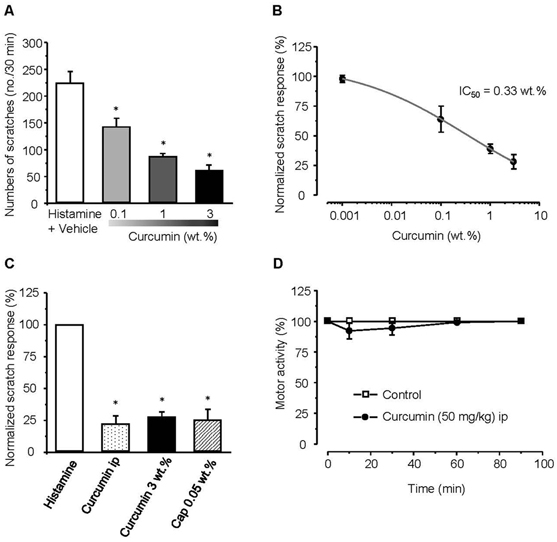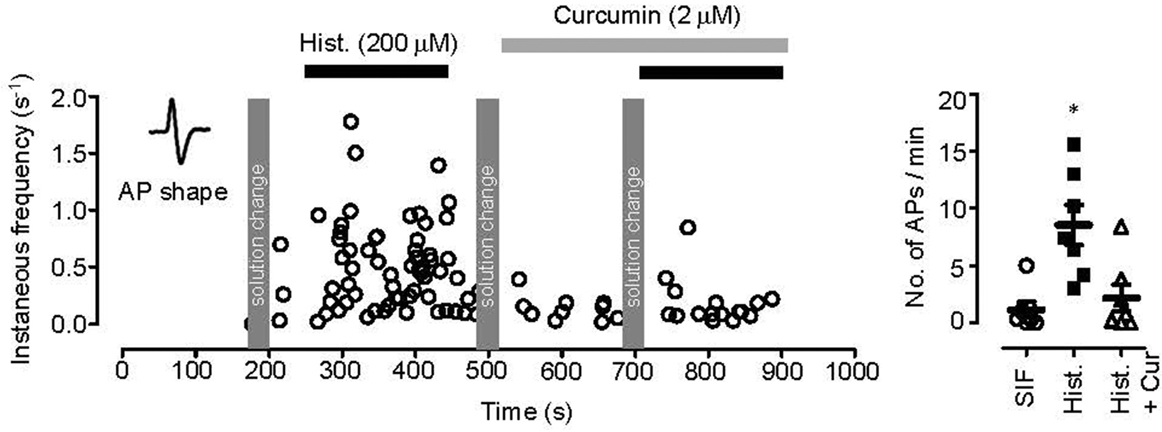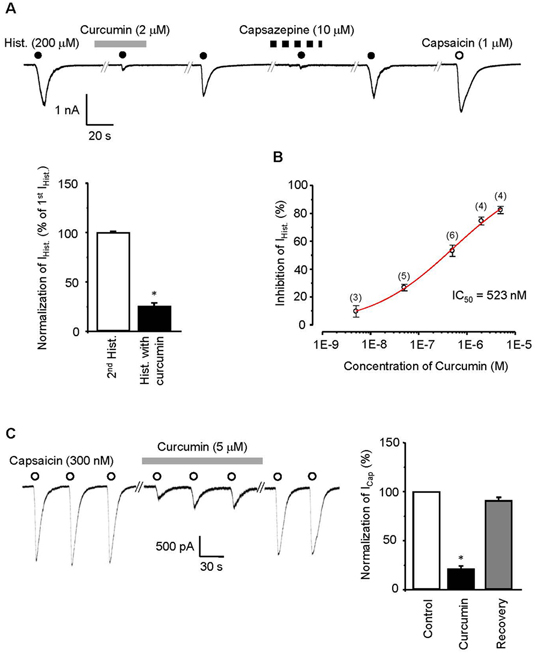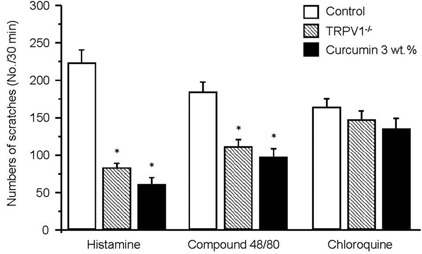Korean J Physiol Pharmacol.
2018 Sep;22(5):547-554. 10.4196/kjpp.2018.22.5.547.
Antipruritic effect of curcumin on histamine-induced itching in mice
- Affiliations
-
- 1Department of Biomedical Science, Graduate School of Biomedical Science and Engineering, Hanyang University, Seoul 04763, Korea. eurijj@hanyang.ac.kr
- 2Department of Physiology, College of Medicine, Kangwon National University, Chuncheon 24341, Korea.
- 3Department of Physiology and Biomedical Engineering, Mayo Clinic, Rochester, MN 55902, USA.
- KMID: 2419004
- DOI: http://doi.org/10.4196/kjpp.2018.22.5.547
Abstract
- Itching is a common clinical symptom of skin disease that significantly affects a patient's quality of life. Transient receptor potential vanilloid 1 (TRPV1) receptors of keratinocytes and peripheral nerve fibers in skin are involved in the regulation of itching as well as pain. In this study, we investigated whether curcumin, which acts on TRPV1 receptors, affects histamine-induced itching in mice, using behavioral tests and electrophysiological approaches. We found that histamine-induced itching was blocked by topical application of curcumin in a concentration-dependent manner. In ex-vivo recordings, histamine-induced discharges of peripheral nerves were reduced by the application of curcumin, indicating that curcumin acts directly on peripheral nerves. Additionally, curcumin blocked the histamine-induced inward current via activation of TRPV1 (curcumin ICâ‚…â‚€=523 nM). However, it did not alter chloroquine-induced itching behavior in mice, which is associated with transient receptor potential ankyrin 1 (TRPA1). Taken together, our results suggest that histamine-induced itching can be blocked by topical application of curcumin through the inhibitory action of curcumin on TRPV1 receptors in peripheral nerves.
MeSH Terms
Figure
Reference
-
1. Aggarwal BB, Harikumar KB. Potential therapeutic effects of curcumin, the anti-inflammatory agent, against neurodegenerative, cardiovascular, pulmonary, metabolic, autoimmune and neoplastic diseases. Int J Biochem Cell Biol. 2009; 41:40–59.
Article2. Aggarwal BB, Sung B. Pharmacological basis for the role of curcumin in chronic diseases: an age-old spice with modern targets. Trends Pharmacol Sci. 2009; 30:85–94.
Article3. Kuttan R, Sudheeran PC, Josph CD. Turmeric and curcumin as topical agents in cancer therapy. Tumori. 1987; 73:29–31.
Article4. Chen HW, Huang HC. Effect of curcumin on cell cycle progression and apoptosis in vascular smooth muscle cells. Br J Pharmacol. 1998; 124:1029–1040.
Article5. Liu JY, Lin SJ, Lin JK. Inhibitory effects of curcumin on protein kinase C activity induced by 12-O-tetradecanoyl-phorbol-13-acetate in NIH 3T3 cells. Carcinogenesis. 1993; 14:857–861.
Article6. Shah BH, Nawaz Z, Pertani SA, Roomi A, Mahmood H, Saeed SA, Gilani AH. Inhibitory effect of curcumin, a food spice from turmeric, on platelet-activating factor- and arachidonic acid-mediated platelet aggregation through inhibition of thromboxane formation and Ca2+ signaling. Biochem Pharmacol. 1999; 58:1167–1172.7. Zhang F, Altorki NK, Mestre JR, Subbaramaiah K, Dannenberg AJ. Curcumin inhibits cyclooxygenase-2 transcription in bile acid- and phorbol ester-treated human gastrointestinal epithelial cells. Carcinogenesis. 1999; 20:445–451.
Article8. Martelli L, Ragazzi E, di Mario F, Martelli M, Castagliuolo I, Dal Maschio M, Palù G, Maschietto M, Scorzeto M, Vassanelli S, Brun P. A potential role for the vanilloid receptor TRPV1 in the therapeutic effect of curcumin in dinitrobenzene sulphonic acid-induced colitis in mice. Neurogastroenterol Motil. 2007; 19:668–674.
Article9. Yeon KY, Kim SA, Kim YH, Lee MK, Ahn DK, Kim HJ, Kim JS, Jung SJ, Oh SB. Curcumin produces an antihyperalgesic effect via antagonism of TRPV1. J Dent Res. 2010; 89:170–174.
Article10. Zhi L, Dong L, Kong D, Sun B, Sun Q, Grundy D, Zhang G, Rong W. Curcumin acts via transient receptor potential vanilloid-1 receptors to inhibit gut nociception and reverses visceral hyperalgesia. Neurogastroenterol Motil. 2013; 25:e429–e440.
Article11. Johanek LM, Meyer RA, Hartke T, Hobelmann JG, Maine DN, LaMotte RH, Ringkamp M. Psychophysical and physiological evidence for parallel afferent pathways mediating the sensation of itch. J Neurosci. 2007; 27:7490–7497.
Article12. Jeffry J, Kim S, Chen ZF. Itch signaling in the nervous system. Physiology (Bethesda). 2011; 26:286–292.
Article13. Namer B, Hilliges M, Orstavik K, Schmidt R, Weidner C, Torebjörk E, Handwerker H, Schmelz M. Endothelin 1 activates and sensitizes human C-nociceptors. Pain. 2008; 137:41–49.14. Carstens E, Akiyama T. Itch: Mechanisms and treatment. Boca Raton, Florida: CRC Press/Taylor & Francis;2014.15. Simone DA, Alreja M, LaMotte RH. Psychophysical studies of the itch sensation and itchy skin (“alloknesis”) produced by intracutaneous injection of histamine. Somatosens Mot Res. 1991; 8:271–279.
Article16. Imamachi N, Park GH, Lee H, Anderson DJ, Simon MI, Basbaum AI, Han SK. TRPV1-expressing primary afferents generate behavioral responses to pruritogens via multiple mechanisms. Proc Natl Acad Sci U S A. 2009; 106:11330–11335.
Article17. Shim WS, Tak MH, Lee MH, Kim M, Kim M, Koo JY, Lee CH, Kim M, Oh U. TRPV1 mediates histamine-induced itching via the activation of phospholipase A2 and 12-lipoxygenase. J Neurosci. 2007; 27:2331–2337.
Article18. Shim WS, Oh U. Histamine-induced itch and its relationship with pain. Mol Pain. 2008; 4:29.
Article19. Kim DC, Kim SH, Choi BH, Baek NI, Kim D, Kim MJ, Kim KT. Curcuma longa extract protects against gastric ulcers by blocking H2 histamine receptors. Biol Pharm Bull. 2005; 28:2220–2224.
Article20. Mosley CA, Liotta DC, Snyder JP. Highly active anticancer curcumin analogues. Adv Exp Med Biol. 2007; 595:77–103.
Article21. Yang F, Lim GP, Begum AN, Ubeda OJ, Simmons MR, Ambegaokar SS, Chen PP, Kayed R, Glabe CG, Frautschy SA, Cole GM. Curcumin inhibits formation of amyloid beta oligomers and fibrils, binds plaques, and reduces amyloid in vivo. J Biol Chem. 2005; 280:5892–5901.22. Chen Y, Wu Q, Zhang Z, Yuan L, Liu X, Zhou L. Preparation of curcumin-loaded liposomes and evaluation of their skin permeation and pharmacodynamics. Molecules. 2012; 17:5972–5987.
Article23. Vaughn AR, Branum A, Sivamani RK. Effects of turmeric (Curcuma longa) on skin health: a systematic review of the clinical evidence. Phytother Res. 2016; 30:1243–1264.
Article24. Lee JY, Shin TJ, Choi JM, Seo KS, Kim HJ, Yoon TG, Lee YS, Han H, Chung HJ, Oh Y, Jung SJ, Shin KJ. Antinociceptive curcuminoid, KMS4034, effects on inflammatory and neuropathic pain likely via modulating TRPV1 in mice. Br J Anaesth. 2013; 111:667–672.
Article25. Ming-Tatt L, Khalivulla SI, Akhtar MN, Mohamad AS, Perimal EK, Khalid MH, Akira A, Lajis N, Israf DA, Sulaiman MR. Antinociceptive activity of a synthetic curcuminoid analogue, 2,6-bis-(4-hydroxy-3-methoxybenzylidene)cyclohexanone, on nociception-induced models in mice. Basic Clin Pharmacol Toxicol. 2012; 110:275–282.
Article26. Panahi Y, Sahebkar A, Amiri M, Davoudi SM, Beiraghdar F, Hoseininejad SL, Kolivand M. Improvement of sulphur mustard-induced chronic pruritus, quality of life and antioxidant status by curcumin: results of a randomised, double-blind, placebo-controlled trial. Br J Nutr. 2012; 108:1272–1279.
Article27. Wilson SR, Gerhold KA, Bifolck-Fisher A, Liu Q, Patel KN, Dong X, Bautista DM. TRPA1 is required for histamine-independent, Masrelated G protein-coupled receptor-mediated itch. Nat Neurosci. 2011; 14:595–602.
Article28. Liu Q, Tang Z, Surdenikova L, Kim S, Patel KN, Kim A, Ru F, Guan Y, Weng HJ, Geng Y, Undem BJ, Kollarik M, Chen ZF, Anderson DJ, Dong X. Sensory neuron-specific GPCR Mrgprs are itch receptors mediating chloroquine-induced pruritus. Cell. 2009; 139:1353–1365.
Article29. Kuraishi Y, Nagasawa T, Hayashi K, Satoh M. Scratching behavior induced by pruritogenic but not algesiogenic agents in mice. Eur J Pharmacol. 1995; 275:229–233.
Article30. Choi YH, Yan GH, Chai OH, Song CH. Inhibitory effects of curcumin on passive cutaneous anaphylactoid response and compound 48/80-induced mast cell activation. Anat Cell Biol. 2010; 43:36–43.
Article31. Nugroho AE, Ikawati Z, Sardjiman , Maeyama K. Effects of benzylidenecyclopentanone analogues of curcumin on histamine release from mast cells. Biol Pharm Bull. 2009; 32:842–849.
Article
- Full Text Links
- Actions
-
Cited
- CITED
-
- Close
- Share
- Similar articles
-
- Crotamiton, an Anti-Scabies Agent, Suppresses Histamine- and Chloroquine-Induced Itch Pathways in Sensory Neurons and Alleviates Scratching in Mice
- Effect of conjugated linoleic acid on compound 48/80-induced pruritus in mice
- Inhibitory effects of curcumin on passive cutaneous anaphylactoid response and compound 48/80-induced mast cell activation
- Effect of Curcumin in a Mouse Model of Oxygen-Induced Retinopathy
- Effect of Acupuncture on Histamine Induced Itch





